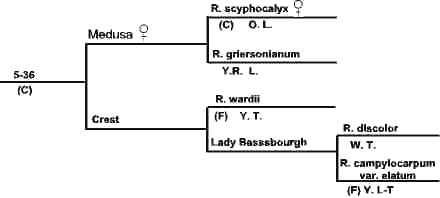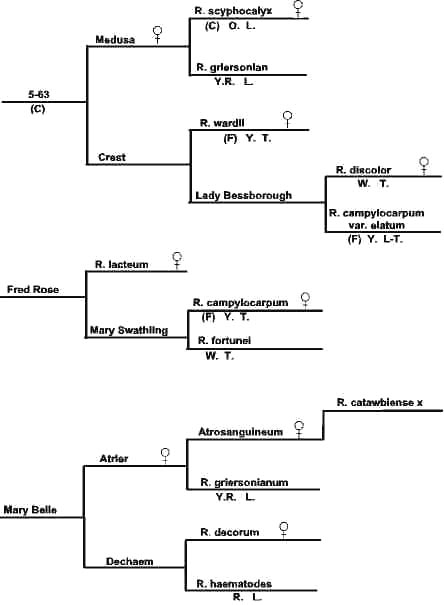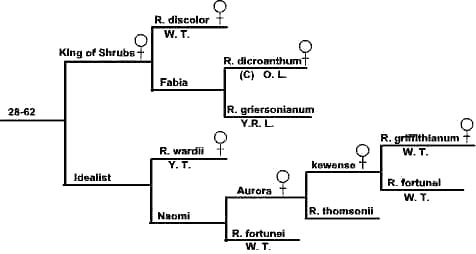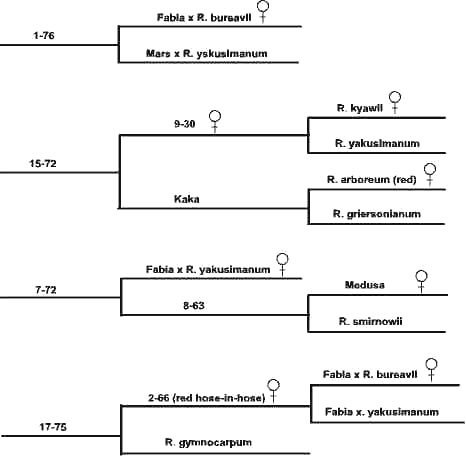QBARS - v31n3 Breeding for Yellow and Indumented Rhododendrons
Breeding for Yellow and Indumented Rhododendron
Arthur Childers, Vida, Oregon
From a paper given at the 1977 Breeders Roundtable in Eugene, Oregon
My interest in rhododendrons began in 1947 with 'Purple Splendour'. The appeal of rhododendrons grew with me so that by the early 1950's I was a regular visitor or perhaps nuisance to most of the gardens and nurseries between Eugene and Portland. The James's garden in Eugene was especially good. I admired the work they were doing and so during the 1950's I acquired most of their better yellow hybrids.
I began hybridizing in 1956. Since that time I have made a total of 760 crosses. Of these crosses, 260 were specifically bred for yellow and 67 were made for indumentum. Initially I grew 100 seedlings from each cross. However, as my health has deteriorated, I have had to settle for 20 or 25 seedlings.
Selecting seedlings for further observation has not always been my choosing. While I have burned thousands that were not improvements, Mother Nature has also been instrumental and perhaps a little too energetic. When sixty inches of snow crushed my lath house in 1968, I saved less than 100 of 10,000 seedlings. The freeze of 1972 was devastating. Approximately 20,000 of my seedlings were killed. Those that survived are now beginning to bloom again. Some are as much as ten years old.
The severe cold we are capable of having has influenced my work. I have begun working with some of the very hardy plants that Dr. Kehr has sent me. I am also using R. yakushimanum and R. smirnowii . We have a wealth of material on the West Coast to use in hybridizing. We tend to forget that we can have severe weather from time to time that can ruin many years of work. Many of our new hybrids are really only suitable for growing in California. I am now working to produce plants that will grow well in 50 per cent of the growing area of the United States. I believe plants should be acceptable to the public as to habit and flower. Also, the plants should be easy to propagate. Before naming my plants I believe they must have several years of observation. Plants that haven't proven themselves may make a fast gain in popularity and then a fast decline and be forgotten.
My first attempts at hybridizing for yellows were complete failures as far as yellow was concerned. Some of my better pinks and whites, however, were made or I should say derived from these crosses. Some of these have been named. As of this date I have a possible ten or fifteen yellow hybrids. A cross made in 1960 of 'Fawn' x 'Crest' produced ninety whites and one ivory. I have discarded all but one white which I will name this year. After seventeen years I believe it has proven itself. The lesson I have learned from this and similar crosses has been a major factor in determining future crosses.
I was fortunate to have in my collection all the major yellow species in select forms. My collection contained three selections of R. wardii (K. W. 4170, K. W. 5736, and L. & S. 5679), three selections of R. campylocarpum , R. dichroanthum Exbury Orange, R. caloxanthum Exbury Orange, R. lacteum Tower-court form (Truss), and more recently a good form of R. aureum (Truss), R. caucasicum yellow (Truss) and R. macabeanum F.C.C. (Truss) from Exbury. These and nearly all of the better yellow hybrids available in this country have been the nuclei of my breeding stock.
As I was not trained in the field of genetics (and after the lessons learned in my initial crosses), I have spent many long winter evenings preparing charts of the plants I intended to cross in the spring. I use the International Registry and draw complete pedigree sheets on each hybrid I intend to use. By comparing pedigrees I can as a rule discard the unwanted combinations. I break down the species in the parentage in fractions as to color, truss shape and plant habit. I try to keep unwanted characteristics to no more than one-fourth to three-eights of this total. Now this is no sure fire solution as there are many unknown factors involved, but it has raised my batting average by a good many points.
I know a good many of you will doubt my theories and some of you will disagree. I admit there are many exceptions. One exception is 'Yellow Bobolink' ( R. discolor x R. neriiflorum ). When crossed with R. wardii it gives its hybrids deeper color than R. wardii crossed with R. dichroanthum . Also R. wardii crossed with R. dichroanthum gives very undesirable lax trusses and bicolored flowers. Another exception is 'Idealist' which is probably one of the best parents known.
We are all familiar with the dilution of colors by the use of lighter colors. We hardly ever get a seedling in any cross that is darker than its parents or ancestors. It has been my theory that, if possible, it is desirable to dilute red and orange with yellow instead of white. I have made many initial crosses by recombining the yellow, red and orange-red crosses with the yellow and greenish-yellow hybrids. The early results of these combinations have been more than satisfactory, but not perfect.
I will try to give you some visual combinations of my theories on why they should or should not work.
This first chart shows my 5-63, 'Medusa' x 'Crest'.
|
Chart 1 |

|
My 5-63, 'Medusa' x 'Crest', is the deepest yellow that I personally have seen. The habit is good. It holds its foliage well. The flowers are large but the truss is very lax. The percentage of good in the parentage rates sibing or selfing, but my efforts haven't been successful. When crossed with unrelated plants however, I've been very successful. I would like to use this plant to show how I figure my percentages. In figuring percentages I look only at the species, yet taking into account the dominant color and habit shown in the hybrid. R, campylocarpum is counted as having one point for yellow and one point for a loose, but not lax, truss and a medium plant habit. R. wardii is rated the same. R. scyphocalyx has an orange flower, a very lax truss and a neat habit. I add this to the yellow group which gives three points for yellow. R. griersonianum is a yellow pigmented red, with large flowers, a lax truss and a loose habit. This gives one point for the yellow-red. R. discolor has a large white flower, good truss, tall open habit and a weakness for dropping all but the current season's leaves. This is transferred many times in primary crosses. R. discolor rates one point for white. I show these ratings as fractions.
| 3/5 - 2 points yellow, 1 point orange |
| 1/5 - 1 point yellow-red |
| 1/5 - 1 point white |
| 3/5 - 3 points for good habit |
| 2/5 - 2 points against R. griersonianum , R. discolor |
On this next chart I am using a very excellent and well known eastern hybrid, Gable's 'Mary Belle', a very excellent and well known western hybrid, Lem's 'Fred Rose', and my own #5-63 ('Medusa' x 'Crest') that I have just been talking about. (Chart 2) Using my formula, 'Fred Rose' can be crossed either way with #5-63 as both are carotenoid yellows, but 'Fred Rose' should be the seed parent with 'Mary Belle'. 'Mary Belle' and #5-63 should not be crossed. I waited three years for 'Mary Belle' to bloom and then decided my percentages were against me. They have everything going for them but the trusses and the formula works out five for the four against it, which is close when you consider how dominant the lax trusses of the Neriiflorum Series are.
|
Chart 2 |

|
Next I would like to show a slide and the parentage chart (Chart 3) of my 28-62, 'King of Shrubs' x 'Idealist'. The thirty plants that bloomed were all in the different shades of yellow. The range in the 'Idealist' side almost forbids selfing or sibling crossing.
| Chart 3 |

|
On the next chart I have shown only a few of my crosses. (Chart 4) I have selected these for further study. Many of these are not suitable for commercial purposes or naming. Some are not even yellow but rather in the pastel and bicolor ranges of yellow and yellow-pink to orange and copper.
| Chart 4 | ||
| 14582 x Solid Copper | Jalisco Elect x Skipper | R. dichroanthum x Ole Olsen |
| Wizard x Tally Ho x Azor | Jalisco x Vida | Mariloo x R. macabeanum x Loderi |
| King of Shrubs x yellow fortunei #2 | Francis Hanger x 14-582 Medusa x Crest | Yellow fortunei #3 x Odee Wright |
| Tyee x Warm Springs | Medusa x Idealist | 1458 x Odee Wright |
| Warm Springs x Yellow Creek | Bow Bells x Crest | Prelude x Crest |
| Yellow Creek x Warm Springs | R. decorum seedling x Crest | |
| Warm Springs x Skipper | Fawn x Lem's Goal | |
| Jalisco Jubilant x Warm Springs | King of Shrubs x Idealist | |
Some, where I used too much R. griersonianum and R. dichroanthum have very undesirably long pedicels and lily-like flowers. Some are quite excellent and others are not. Most of the plants, if properly crossed, should make excellent parents. Then this is all in the future of another lifetime. After years of trial and error in hybridizing one finds plants that are consistently good parents. Halfdan Lem told me this twenty years ago but it took me several more years of work to say, "I believe him." Some of the best parents I've found in hybrids have been 'Idealist', 'Crest', 'Warm Springs', 'Medusa', 'Yellow Bobolink', Yellow Creek", 'King of Shrubs', 'Odee Wright', 'Mariloo', and some of my own numbered hybrids. Other hybrids
such as the 'Jalisco Grex', 'Penny', 'Margaret Dunn', 'Golden Belle', 'Francis Hanger', 'Hotel' and many others have not proved to be the best parents. There are some hybrids that bring unexpected results as parents. Cross 'Mrs. Furnival' with 'Crest' or 'Full Moon' and you get good light yellow ball trusses. Cross Crest' with 'Bow Bells' and you get about half yellows. I crossed 'Crest' with a white R. decorum seedling and got 100 percent yellows. I've selected two fine plants.
I had never heard of research being done on the yellow pigments flavanol and caroten until I read the article in the American Rhododendron Society Quarterly Bulletin, Volume 27, Number 4, October 1973, on "Yellow Flower Pigments in Rhododendrons: A Review for Breeders" by Santamour and Pryor. After reading the article I checked my previous crosses and almost without exception the formulas hold true. From that point I have tried to make sure my crosses were made with the carotenoid plants as the female and the flavanol plants as the male. This could be why the English have had better luck with R. lacteum crosses than we have had here. R. lacteum should be the seed parent and all we have had was its pollen. On this next chart I will give you a visual picture of reciprocal crosses I have made and flowered. (Chart 5)
| Chart 5 | |
| 5-63 | |
| Y. | 2 Loose Truss |
| O. | 1 Lax Truss |
| R. | 1 Lax Truss |
| W. | 1 Loose Truss 'Mary Belle' |
| Y. R. | 1 Lax Truss |
| Y. R. | 1 Lax Truss |
| R. | 1 Tight Truss |
| W | 1 Loose Truss 'Fred Rose' |
| Y. | 1 Tight Truss |
| Y. | 1 Tight Truss |
| W. | 1 Loose Truss |
Where the seed parent was 'Warm Springs' (carotenoid) x 'Yellow Creek', all the seedlings were light oranges and rather warm yellows. The opposite cross of 'Yellow Creek' (flavonol) x 'Warm Springs' gave offspring in the greenish yellow shades. These comparisons were made using the RHS Colour Charts. Both crosses produced 100 per cent yellow and yellow-orange seedlings.
At the present I have many young seedlings for which I have high hopes. They have been put together with more thought for better combinations. The hope is there that one will be the perfect one. Yet, I have the experience to know they can be failures.
I think I have said enough about yellow rhododendrons. I promised to talk a little about indumented plants as I've always admired beautiful foliage plants and most of the indumented plants are just that, beautiful plants.
I started about 1970 with a few indumented hybrids as a foundation, so many of my secondary crosses are still quite young. With R. yakushimanum and R. smirnowii as the seed parents I have crossed many of the indumented species and hybrids. Now, I'm beginning to use my percentage formula on both color of indumentum and flower. Also, I've selected plants that show an unusual amount of indumentum on the top surface of the leaves. At present some hold a scurf of indumentum on the top surface for a year or longer. Some have yellow indumentum, some almost red and many shades of buff. I'm even hopeful some of my very small seedlings will have orange and pink indumentum.
Some years ago someone told me not to use R. smirnowii as a parent as it had blue in it and it was just a poor plant. I've wished many times in recent years I would have depended on my own judgment and used it. Lem did and some of his primary and secondary hybrids are very valuable as foundation stock. You can cross it with most colors and get non-fading flowers, even red and yellow. Examples are Lem's' Holy Moses' and Shammarillo's good pink 'King Tut'. I have it crossed with 'Medusa' and have some fine yellow-pinks and a non-fading red. These are under my number 8-63. They bloomed after going through 20° below zero. Most have been difficult to hybridize though.
Most of my primary crosses using R. yakushimanum have been about the same as everyone else's, good plants and flowers but mostly fading. But by selecting the better plants and deeper, more lasting colors and crossing back to a solid colored indumented plant as a secondary cross, what few I've bloomed so far are showing real promise. If I used R. yakushimanum in the primary cross I didn't use it in the secondary. I've treated R. smirnowii in the same way. I've tried to keep R. yakushimanum to my percentage formula of three-eighths to one-fourth and where possible to use plants with solid color for the other parent. You can see this on the chart showing some of my primary and secondary crosses. (Chart 6).
| CHART 6 |

|
Also I would like to show you on a list of my primary and secondary crosses some of the work I have been doing in hybridizing for flower color on indumented plants. (Chart 7 & 8).
| CHART 7 | |
| Primary Crosses (Indumentum) | |
| R. yakushimanum x R. floribundum 'Swinhoe' | |
| Blue | R. yakushimanum x R. campanulatum 'Knaphill' |
| Purple | R. wallichii x 'Purple Elegans' |
| R. yakushimanum x R. bureavii | |
| Pink | R. yakushimanum x R. adenophorum |
| White | R. yakushimanum x 'Sir Charles Lemon' |
| R. yakushimanum x R. aureum | |
| R. yakushimanum x R. lacteum | |
| R. yakushimanum x R. wardii | |
| Cream | R. yakushimanum x Medusa x Crest |
| Yellow | R. yakushimanum x R . dichroanthum 'Exbury Orange' |
| R. yakushimanum x 'Holy Moses' Lem | |
| R. yakushimanum x 'Fabia' | |
| R. smirnowii x R. elliottii | |
| Pink | R. smirnowii x 'Medusa' |
| Red | R. smirnowii x 'America' Shammarillo |
| R. yakushimanum x | |
| ( R. haematodes x eriogynum ) 'Grosclaude' | |
| R. yakushimanum x R. mallotum | |
| R. yakushimanum x R. kyawii | |
| R. yakushimanum x R. haematodes | |
| Red | R. yakushimanum x |
| ( R. arboreum x griersonianum ) 'KaKa' | |
| R. yakushimanum x 'Mars' | |
| R. yakushimanum x 'Ibex' | |
| R. yakushimanum x R. strigillosum | |
| R. bureavii x 'Fabia' | |
| R. degronianum x 'Grosclaude' | |
| R. adenophorum x 'Grosclaude' | |
|
CHART 8 |
|
|
Secondary Crosses (Indumentum) |
|
| Fabia x R. bureavii x R. yakushimanum x 'Mars' | |
| Fabia x R. bureavii x 'Fabia' x R. yakushimanum | |
| Fabia x R. bureavii x 'Mars' x R. yakushimanum | |
| Fabia x R. bureavii x 'Medusa' x R. smirnowii | |
| R. yakushimanum x R. kyawii x 'Kaka' | |
| R. yakushimanum x 'Mars' | |
| ( R. strigillosum x' Elizabeth') 'Maxine Margaret' | |
| Fabia x R. bureavii x 'Fabia' x | |
| R. yakushimanum x R. gymnocarpum | |
In closing I would like to thank Dr. Ticknor for giving me this opportunity to talk about a subject that is very dear to my heart. I could go on talking indefinitely but the more subjects you touch, the more confusion you can create. After a few years each of us finds the plants that produce best for us. We each feel we are right and we are. There is no sure formula in breeding rhododendrons. If there were, we wouldn't be here today. The ideas I've expressed are only one man's. Every one of you that is hybridizing plants has your own ideas and you are right. One hundred years from now whoever is working with rhododendrons will know who the lucky ones of our generation were as the plants made now, and are still sought after then, will be the proof.
Thank you.
